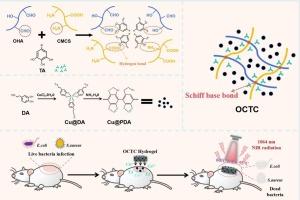具有TA/Cu2+释放和NIR-II光热协同抗菌和抗氧化性能的水凝胶用于细菌感染伤口愈合
IF 6.3
2区 化学
Q1 POLYMER SCIENCE
引用次数: 0
摘要
细菌感染对人体皮肤创面愈合造成严重威胁,其产生的活性氧(reactive oxygen species, ROS)可显著延缓创面愈合进程,最终导致慢性创面形成,甚至危及人的生命。因此,本研究利用氧化透明质酸(OHA)、羧甲基壳聚糖(CMCS)和单宁酸(TA),通过希夫碱键和氢键的双交联,成功构建了动态可逆的水凝胶网络。通过加载Cu@PDA制备OCTC2水凝胶创面敷料,通过TA/Cu2+释放和NIR-II光热效应表现出协同抗菌和抗氧化性能。我们用FTIR, XRD, SEM和TEM对Cu@PDA和水凝胶的具体组成和形态进行了深入的分析。我们测量了每组水凝胶的可注射性、粘附性、NIR-II光热性和抗菌性。结果表明,TA和Cu@PDA使水凝胶具有优异的抗氧化性能,能够有效清除各种自由基。此外,OCTC2具有TA/Cu2+缓释能力,对金黄色葡萄球菌和大肠杆菌的抑菌率超过94%。在NIR-II光热疗法的联合作用下,能达到高效的细菌杀灭率(99.8%),有效促进细菌感染创面的愈合。OCTC2有望成为治疗细菌感染伤口的潜在理想水凝胶敷料。本文章由计算机程序翻译,如有差异,请以英文原文为准。

Hydrogels with TA/Cu2+ release and NIR-II photothermal synergistic antibacterial and antioxidant properties for healing of bacterial-infected wounds
Bacterial infections pose a significant threat to the healing of human skin wounds, as the reactive oxygen species (ROS) they produce can significantly delay the wound healing process, ultimately leading to the formation of chronic wounds and even endangering human life. Therefore, this study successfully constructed a dynamically reversible hydrogel network through dual crosslinking of Schiff base bonds and hydrogen bonds using oxidized hyaluronic acid (OHA), carboxymethyl chitosan (CMCS), and tannic acid (TA). By loading Cu@PDA, the OCTC2 hydrogel wound dressing was prepared, exhibiting synergistic antibacterial and antioxidant properties through TA/Cu2+ release and NIR-II photothermal effects. We used FTIR, XRD, SEM, and TEM to thoroughly analyse the specific composition and morphology of the Cu@PDA and hydrogel. We measured the injectability, adhesion, NIR-II photothermal, and antibacterial properties of each group of hydrogels. The results showed that TA and Cu@PDA endowed the hydrogel with excellent antioxidant properties, enabling effective scavenging of various free radicals. Additionally, OCTC2, which possesses sustained-release TA/Cu2+ capability, achieves antibacterial rates of over 94 % against S. aureus and E. coli. Under the combined effect of NIR-II photothermal therapy, it can achieve highly efficient bacterial killing (99.8 %), effectively promoting the healing of bacterial infection wounds. OCTC2 holds promise as a potential ideal hydrogel dressing for treating bacterial-infected wounds.
求助全文
通过发布文献求助,成功后即可免费获取论文全文。
去求助
来源期刊

European Polymer Journal
化学-高分子科学
CiteScore
9.90
自引率
10.00%
发文量
691
审稿时长
23 days
期刊介绍:
European Polymer Journal is dedicated to publishing work on fundamental and applied polymer chemistry and macromolecular materials. The journal covers all aspects of polymer synthesis, including polymerization mechanisms and chemical functional transformations, with a focus on novel polymers and the relationships between molecular structure and polymer properties. In addition, we welcome submissions on bio-based or renewable polymers, stimuli-responsive systems and polymer bio-hybrids. European Polymer Journal also publishes research on the biomedical application of polymers, including drug delivery and regenerative medicine. The main scope is covered but not limited to the following core research areas:
Polymer synthesis and functionalization
• Novel synthetic routes for polymerization, functional modification, controlled/living polymerization and precision polymers.
Stimuli-responsive polymers
• Including shape memory and self-healing polymers.
Supramolecular polymers and self-assembly
• Molecular recognition and higher order polymer structures.
Renewable and sustainable polymers
• Bio-based, biodegradable and anti-microbial polymers and polymeric bio-nanocomposites.
Polymers at interfaces and surfaces
• Chemistry and engineering of surfaces with biological relevance, including patterning, antifouling polymers and polymers for membrane applications.
Biomedical applications and nanomedicine
• Polymers for regenerative medicine, drug delivery molecular release and gene therapy
The scope of European Polymer Journal no longer includes Polymer Physics.
 求助内容:
求助内容: 应助结果提醒方式:
应助结果提醒方式:


